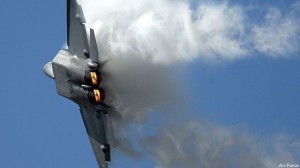F-22s Coming To Australia Next Year: PACOM’s Adm. Harris
Posted on

SYDNEY: While it will be a short deployment, Australia and the United States have agreed to deploy America’s most advanced fighter next year as part of the Enhanced Air Cooperation (EAC) Initiative that has seen B-2 bombers and other advanced American aircraft deployed to the lucky country.
Adm. Harry Harris, head of Pacific Command, disclosed the news during a Q and A session at the Lowy Institute, a foreign policy thinktank here. Harris, fresh from a short visit to the seemingly always turbulent island state of Papua New Guinea, did not disclose how many F-22s would fly to the Royal Australian Air Force‘s base in Tindal.
While the US Marines have gotten most of the press for their now sort of regular six-month deployments to the northern port city of Darwin, 2017 marks a significant ramp-up in the air portion of America’s military commitment to — arguably — our closest ally.
While some journalists had already heard about the F-22 deployment, it was disclosed off the record. Harris decided to make it public in response to a question by an Australian reporter. There were concerns that Indonesia might react badly since, in the words of one source, they think everything that happens here is about them.” Indonesia and Australia have long had a very fractious, complicated and often antagonistic relationship.

F-22
In his public speech, Harris also reitereated the US commitment to open seas and freedom of navigation throughout the South China Sea, where China has destroyed large coral reefs to build temporary islands where they are deploying military ships and planes in a clear effort to execute a fait accompli and control access to an area a UN tribunal ruled earlier this year China has no legitimate claim to.
In his prepared remarks, Harris said that “the Indo-Asia-Pacific economic miracle is coming under pressure from revisionist powers (Russia and China).” How should the US and its allies and partners react? Harris offered three tools: “the absolute necessity to maintain credible combat power;” resolve; and, finally, expanding partnerships. “These partnerships advance national interests outside the confines of the old US hub and spoke alliance model,” Harris said.
When I asked Harris what concrete measures the US and allies could take to counter China’s revanchist actions in the South China Sea, he took issue with our focus on military power, saying that diplomacy and other tools of national power were the most likely to change China’s behavior.
Subscribe to our newsletter
Promotions, new products and sales. Directly to your inbox.
